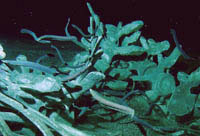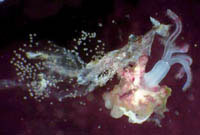Research News
- Astronomer gets boost in search for new planets
- Pineapple trick inspires winter-flowering plumeria
- Herbarium project increases access to collections
- Book tells all about breadfruit
- Low-fat diet is shown to slow diabetic eye disease
- Vaccines tested that could protect endangered birds
- Dark lunar poles could shed light on Earth’s formation
- Whales, zombie worms and ecological lessons
Astronomer gets boost in search for new planets

A small boat traveling through water can produce a wake that is hundreds of feet long and visible even when the boat is beyond sight. A planet formed in the dust and gas surrounding a new star can also create detectable wake-like patterns.
University of Hawaiʻi at Mānoa astronomer Michael Liu uses the Keck telescope on Mauna Kea to look for the telltale patterns in his quest to understand how planets form. He focuses around young stars, those a mere 10 million years old (compared to our 4.6 billion-year-old solar system).
Liu’s work earned him one of eight Sloan Foundation Research Fellowships awarded to young astrophysicists this year.
A 2005 fellowship also went to Kirill Melnikov, a member of UH Mānoa’s High Energy Physics Group and a U.S. Department of Energy Outstanding Junior Investigator.
topPineapple trick inspires winter-flowering plumeria

Winter visitors to Hawaiʻi are often met with a quintessential greeting of aloha, a plumeria lei… from Thailand? The fragrant lei flowers are imported because few Hawaiʻi plumeria blossom in the decreasing periods of daylight during fall and winter.
Horticulturist Richard Criley of the University of Hawaiʻi at Mānoa College of Tropical Agriculture and Human Resources has a solution. A chemical used by the pineapple industry to stimulate flowering and uniform ripening is applied to the plumeria tree in September and October. Foliage falls off, leaving the tree unable to respond to shortening days. Warm nights, generally above 65 degrees, spur the plants to regrow, producing flowers of the same size and quality as those normally produced in the spring.
topHerbarium project increases access to collections

Information from 42,000 plants in the University of Hawaiʻi at Mānoa’s Lyon Arboretum and Department of Botany herbariums and a Bishop Museum collection will be computerized under a National Science Foundation funded project headed by Professor of Botany Will McClatchey.
The mounted specimens represent entire floras, including rare and endangered species, from Hawaiʻi, Samoa, Tonga and the Marshall Islands. The project will make data more accessible to students and researchers.
topBook tells all about breadfruit
The title of a new book from the University of Hawaiʻi at Mānoa’s College of Agriculture and Human Resources says it all- Hawaiian Breadfruit: Ethnobotany, Nutrition and Human Ecology.
The 61-page book traces the Pacific historical, cultural and dietary significance of the canoe plant known as ʻulu. Published with support from the late Sherwood Greenwell, a rancher/politician devoted to preservation of Kona’s history, the book costs $10.
For information, go to the publication website or call 808 956-7036.
topLow-fat diet is shown to slow diabetic eye disease
Here’s another reason to eat a low-fat, high-fiber diet: it just might stave off diabetes-related eye disease, according to findings by University of Hawaiʻi at Mānoa Associate Professor of Public Health Science and Epidemiology Claudio Nigg.
Nigg and colleague David Cundiff examined nine years of data from the federal Diabetes Control and Complications Trial. They found that following the American Heart Association’s recommended low-fat diet slowed the progression of diabetic retinopathy, which causes 12,000-24,000 people to loose their sight each year. Tobacco use increases the rate of retinopathy progression, as does high blood pressure, obesity and hyperlipidemia—factors that also respond to a low-fat, low-cholesterol, high-fiber diet.
The study was reported in Medscape General Medicine.
topVaccines tested that could protect endangered birds
The red ʻiʻiwi honeycreeper is extremely susceptible to malaria, but the green ʻamakihi is more resistant. University of Hawaiʻi at Hilo biologist Susan Jarvi is conducting genetic studies to figure out why.
Avian malaria and avian pox have endangered endemic bird populations in Hawaiʻi. Jarvi is testing a malaria vaccine, using irradiated mosquitoes to introduce an attenuated parasite into birds in hopes of producing an immune response.
She hopes to also apply her experience to a trial West Nile vaccine developed by a Hawaiʻi firm. While avian malaria doesn’t affect humans, mosquito-borne West Nile virus can be deadly to both birds and humans.
topDark lunar poles could shed light on Earth’s formation
Scientists may have traveled to the ends of the earth, but they have yet to explore the poles of the moon. The tilt of the moon is so minor that the poles are in perpetual shade. Craters there could become super-cold traps for the vapors scattered by comets crashing into the surface, University of Hawaiʻi at Mānoa planetologist Paul Lucey commented during the March 2005 Lunar and Planetary Science Conference in Texas.
Exposed to cosmic rays, the water ice and other cometary materials could be converted into organics, perhaps "waxy, gooey stuff" that isn’t recognized by known radar properties.
Studying the moon sheds light on how impacts may have influenced the development of life on Earth, Lucey says.
topWhales, zombie worms and ecological lessons

When whales die and sink, their skeletons become host to specialized animal communities found nowhere else
Mānoa oceanographer Craig Smith found another reason for preserving whale populations throughout the world: the sunken bodies of dead whales, or whale falls, create unique deep-sea ecosystems.
"Most of the deep ocean floor is very food-poor," Smith says. Little of the food sinking from the ocean surface actually reaches the bottom. But when a big piece of seaweed or a large fish dies and sinks, they support specialized communities of animals.
Smith has been interested in large organic falls and their contribution to the deep-sea food web since his graduate student days at Scripps Institution of Oceanography. For several years, he has focused on "the largest organic parcel in the ocean," the whale.
"When they die, and most of them sink to the sea floor when they die, they’re a huge organic enrichment."

Blind, gutless, centimeter-long zombie worms colonize whale falls, using internal bacterial gardens to consume nutrients in the bones
A succession of communities develop. Scavengers come in and feed first. As surrounding sediments become organic-enriched, specialized animals begin to colonize. Finally, the bones release sulphide, attracting communities of animals similar to those at hydrothermal vents.
In all, Smith has found "something like 37 or 38 species that either are extremely abundant on whale falls and found occasionally in other places, or else haven't been found anywhere but on dead whales."
Some of the animals are bizarre. In 1996, Smith was the first researcher to collect so-called zombie worms, big, gutless worms that burrow into the whale bones and eat the organic material. These blind worms use an internal bacterial garden to consume the proteins and lipids inside whale bones.
"We showed them to worm specialists and nobody knew what they were," he says. About two years ago, researchers at the Monterey Bay Aquarium Research Institute sequenced DNA from larger worms found on a whale fall in deeper water. Monterey scientists found two more worm species and Smith’s team discovered a fifth in shallow waters in Sweden.
All the worms were found exclusively at whale fall sites. "This is a very bizarre kind of worm, highly specialized. It looks like it really could only live on whale bones. I think it&8217;s very likely that they have a worldwide distribution,", Smith says.
If whale populations decline, what happens to the whale fall communities? "During the times of commercial whaling, whales were much less abundant, and their populations are still depleted in some parts of the ocean," he observes. "Certain species, like the blue whale in the Antarctic and North Pacific, are still heavily depleted."
In the North Atlantic after the mid-1800s, whale falls may have been as few as one-tenth the number before whaling. Conservation biology models predict that if you take away 90 percent of a specialized community’s habitat, you typically cause extinction of 30–50 percent of the species that live in that habitat, he notes.
"It’s quite possible that whaling caused extinctions of some of the specialized animals that lived on whale falls and on dead whale skeletons in particular," Smith says. "It's an example of how connected ecosystems are—that if you severely perturb one component of any ecosystem, you may affect other systems in ways you can’t imagine. You need to be very careful in whatever you do and how you exploit species or modify ecosystems."
top